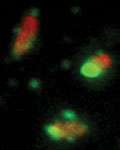Revealing camouflaged bacteria

A research team at the Biozentrum of the University of Basel has discovered an protein family that plays a central role in the fight against the bacterial pathogen Salmonella within the cells. The so called interferon-induced GTPases reveal and eliminate the bacterium's camouflage in the cell, enabling the cell to recognize the pathogen and to render it innocuous. The findings are published in the current issue of the science magazine Nature.
Bacteria have developed countless strategies to hide themselves in order to evade attack by the immune system. In the body, Salmonella bacteria use macrophages as host cells to ensure their survival and to be able to spread within the body. Their survival strategy is to nestle into a vacuole within the cytoplasm of a macrophage, hiding there and multiplying. While they are hidden there, the immune cells cannot detect the bacteria and fight them.
Exposure: GTPases destroy Salmonella's hideout
The macrophages, in which the Salmonella hide, however, have also developed a strategy to unmask the disguise of the bacterium and uncover its hiding place. Prof. Petr Broz's research group at the Biozentrum of the University of Basel has discovered a protein family called interferon-induced GTPases in host cells invaded by Salmonella. "They are responsible for destroying the hiding place of the pathogen and to initiate the immune response of the cell," explains Etienne Meunier, first author of the publication.
Destruction: Kick-off for attacking the bacteria
Once the hiding place has been discovered, GTPases are transported to the vacuole and destabilize its membrane. The bacteria are left behind unprotected in the cytoplasm where their surface molecules are easily recognized by the intracellular defense. "The GTPases are the key to the hiding place of the bacteria. Once the door has been opened and the protective vacuole destroyed, there is no escape. The bacteria are immediately exposed to the defense machinery of the cell", says Meunier. Receptors in the cell identify the pathogen, which then activate special cellular enzymes to destroy the bacteria. In addition, the cells own proteases, so-called caspases, are activated and trigger cell death of the infected host cell.
Salmonella still remain a feared pathogenic agent, as they can cause life threatening diarrheal disease. The findings of Broz and his team enable the better understanding of the strategies of the immune cells and to perhaps model this in the future. The deeper understanding of the immune response of our cells also paves the way for new approaches in using drugs to support the body's fight against pathogens. In order to further elucidate the mechanisms of the immune response to Salmonella infections, the research team plans to investigate how cells detect the hiding place of the bacteria, the vacuole in the cytoplasm of the macrophages, and what initiates the recruitment of GTPases to the vacuole.
More information: Etienne Meunier, Mathias S. Dick, Roland F. Dreier, Nura Schürmann, Daniela Kenzelmann Broz, Søren Warming, Merone Roose-Girma, Dirk Bumann, Nobuhiko Kayagaki, Kiyoshi Takeda, Masahiro Yamamoto and Petr Broz Caspase-11 activation requires lysis of pathogen-containing vacuoles by IFN-induced GTPases Nature (2014); Advance Online Publication, DOI: 10.1038/nature13157
Journal information: Nature
Provided by University of Basel


















